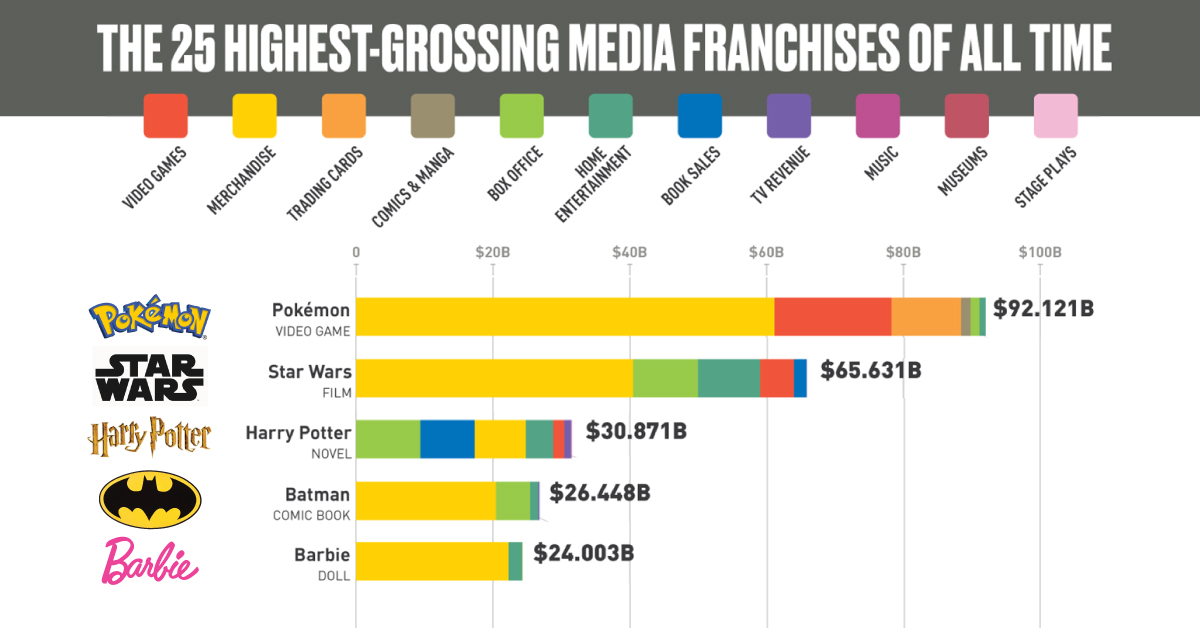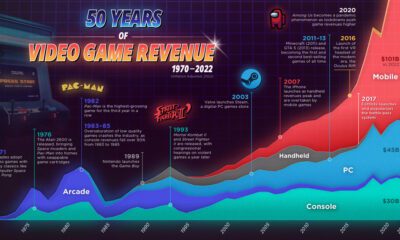Technology
The World’s 25 Most Successful Media Franchises, and How They Stay Relevant

The World’s 25 Most Successful Media Franchises, and How They Stay Relevant
Great stories come and go, but there are a certain few that can truly stand the test of time.
Tugging on the heartstrings with nostalgic stories can be a powerful tool. Yet, even the most world-renowned storytellers like Disney face pressure to constantly innovate.
Today’s infographic from TitleMax illustrates the highest-grossing media franchises, and dives into how they generate their revenue and adapt to new mediums in changing times.
The Supreme Storytellers
According to the infographic, the majority of franchise revenue comes from merchandising. Video games, comic books, and Japanese manga are also significant drivers of income.
| Rank | Franchise | Year Created | Revenue (USD) | Main Revenue Source |
|---|---|---|---|---|
| #1 | Pokémon | 1996 | $92B | Merchandise |
| #2 | Hello Kitty | 1974 | $80B | Merchandise |
| #3 | Winnie the Pooh | 1924 | $75B | Merchandise |
| #4 | Mickey Mouse | 1928 | $70B | Merchandise |
| #5 | Star Wars | 1977 | $66B | Merchandise |
| #6 | Anpanman | 1973 | $60B | Merchandise |
| #7 | Disney Princesses | 2000 | $45B | Merchandise |
| #8 | Mario | 1981 | $36B | Video Games |
| #9 | Jump Comics | 1968 | $34B | Comics and Manga |
| #10 | Harry Potter | 1997 | $31B | Box Office |
| #11 | Marvel Cinematic Universe | 2008 | $29B | Box Office |
| #12 | Spiderman | 1962 | $27B | Merchandise |
| #13 | Gudam | 1979 | $26B | Merchandise |
| #14 | Batman | 1939 | $26B | Merchandise |
| #15 | Dragonball | 1984 | $24B | Comic and Manga |
| #16 | Barbie | 1959 | $24B | Merchandise |
| #17 | Fist of The North Star | 1983 | $22B | Video Games |
| #18 | Cars | 2006 | $22B | Merchandise |
| #19 | Toy Story | 1995 | $20B | Merchandise |
| #20 | One Piece | 1997 | $20B | Comics and Manga |
| #21 | Lord of The Rings | 1937 | $20B | Book Sales |
| #22 | James Bond | 1953 | $20B | Box Office |
| #23 | Yu-Gi-Oh | 1996 | $20B | Trading Cards |
| #24 | Peanuts | 1950 | $17B | Merchandise |
| #25 | Transformers | 1984 | $17B | Merchandise |
Perhaps surprisingly, Marvel is not included in the top 10. Despite nearly $30 billion revenue and a long history rooted in comic books, the entertainment behemoth still has much ground to cover as the newest franchise in the ranking.
Reinventing a Classic
While the list proves that success builds over time, these classics need to constantly reinvent themselves as their audiences become reliant on new technologies and demand more immersive experiences.
Pokémon
As the highest grossing media franchise earning roughly $4 billion a year, Pokémon’s strength lies in it ability to adapt to new technology.
The Japanese phenomenon has continued to reposition itself since it first introduced Pokémon cards in 1996. These days, the franchise is perhaps best known for bringing augmented reality to the masses with Pokémon Go—an app that attracted 50 million users in just 19 days.
Hello Kitty
Yet another Japanese brand tops the list of media franchises. With 50,000 product lines available in over 130 countries and cumulative revenue of $80 billion, Hello Kitty is famous for harnessing the power of cute.
The fictional character has evolved into a globally recognized symbol as a result of big name partnerships and licensing deals with the likes of Puma, Asos and Herschel—and is etched onto almost every type of accessory thinkable.
More recently, the brand announced its foray into video games, and will collaborate with the global esports organization FNATIC on content and merchandise.
Winnie the Pooh
The chronicles of Winnie the Pooh have transcended time by providing a connection to the innate wonder of childhood.
Originally created following World War I, the newest movie rendition “Christopher Robin” became the highest-grossing film in the franchise, grossing $197 million worldwide.
Mickey Mouse
With 97% brand name recognition, Mickey Mouse is officially more recognizable than Santa Claus. Similarly to Winnie the Pooh, Disney introduced Mickey Mouse as a symbol of hope following the World War.
Over 90 years later, global brands such as L’oreal, Beats, Uniqlo and more recently, Gucci are paying homage. In 2019, the luxury fashion brand licensed the Mickey Mouse image for a 3D printed bag worth $4,500, making it even more of a ubiquitous symbol of pop culture.
Star Wars
Another Disney favorite, Star Wars holds the title of most successful movie franchise, with cumulative revenues of $65 billion.
The franchise successfully appeals to a multi-generational audience by mixing old characters with new storylines, such as ‘The Mandalorian’, broadcasting on the new streaming service Disney+—hailed as one of the more exciting moves to come from the saga.
Making Magic
Disney owns three out of the top five highest grossing franchises, so it comes as no surprise that the media conglomerate is investing heavily in digital innovation to provide a more immersive customer experience.
In fact, every franchise in the ranking relies on multiple touchpoints and revenue streams to create a more interactive and emotional experience for their audience.
By harnessing a compelling combination of both imagination and technology, Disney and other top global franchises can continue to lead in the business of making magic.
Brands
How Tech Logos Have Evolved Over Time
From complete overhauls to more subtle tweaks, these tech logos have had quite a journey. Featuring: Google, Apple, and more.

How Tech Logos Have Evolved Over Time
This was originally posted on our Voronoi app. Download the app for free on iOS or Android and discover incredible data-driven charts from a variety of trusted sources.
One would be hard-pressed to find a company that has never changed its logo. Granted, some brands—like Rolex, IBM, and Coca-Cola—tend to just have more minimalistic updates. But other companies undergo an entire identity change, thus necessitating a full overhaul.
In this graphic, we visualized the evolution of prominent tech companies’ logos over time. All of these brands ranked highly in a Q1 2024 YouGov study of America’s most famous tech brands. The logo changes are sourced from 1000logos.net.
How Many Times Has Google Changed Its Logo?
Google and Facebook share a 98% fame rating according to YouGov. But while Facebook’s rise was captured in The Social Network (2010), Google’s history tends to be a little less lionized in popular culture.
For example, Google was initially called “Backrub” because it analyzed “back links” to understand how important a website was. Since its founding, Google has undergone eight logo changes, finally settling on its current one in 2015.
| Company | Number of Logo Changes |
|---|---|
| 8 | |
| HP | 8 |
| Amazon | 6 |
| Microsoft | 6 |
| Samsung | 6 |
| Apple | 5* |
Note: *Includes color changes. Source: 1000Logos.net
Another fun origin story is Microsoft, which started off as Traf-O-Data, a traffic counter reading company that generated reports for traffic engineers. By 1975, the company was renamed. But it wasn’t until 2012 that Microsoft put the iconic Windows logo—still the most popular desktop operating system—alongside its name.
And then there’s Samsung, which started as a grocery trading store in 1938. Its pivot to electronics started in the 1970s with black and white television sets. For 55 years, the company kept some form of stars from its first logo, until 1993, when the iconic encircled blue Samsung logo debuted.
Finally, Apple’s first logo in 1976 featured Isaac Newton reading under a tree—moments before an apple fell on his head. Two years later, the iconic bitten apple logo would be designed at Steve Jobs’ behest, and it would take another two decades for it to go monochrome.
-

 Green1 week ago
Green1 week agoRanked: The Countries With the Most Air Pollution in 2023
-

 AI2 weeks ago
AI2 weeks agoThe Stock Performance of U.S. Chipmakers So Far in 2024
-

 Markets2 weeks ago
Markets2 weeks agoCharted: Big Four Market Share by S&P 500 Audits
-

 Real Estate2 weeks ago
Real Estate2 weeks agoRanked: The Most Valuable Housing Markets in America
-

 Money2 weeks ago
Money2 weeks agoWhich States Have the Highest Minimum Wage in America?
-

 AI2 weeks ago
AI2 weeks agoRanked: Semiconductor Companies by Industry Revenue Share
-

 Travel2 weeks ago
Travel2 weeks agoRanked: The World’s Top Flight Routes, by Revenue
-

 Countries2 weeks ago
Countries2 weeks agoPopulation Projections: The World’s 6 Largest Countries in 2075















